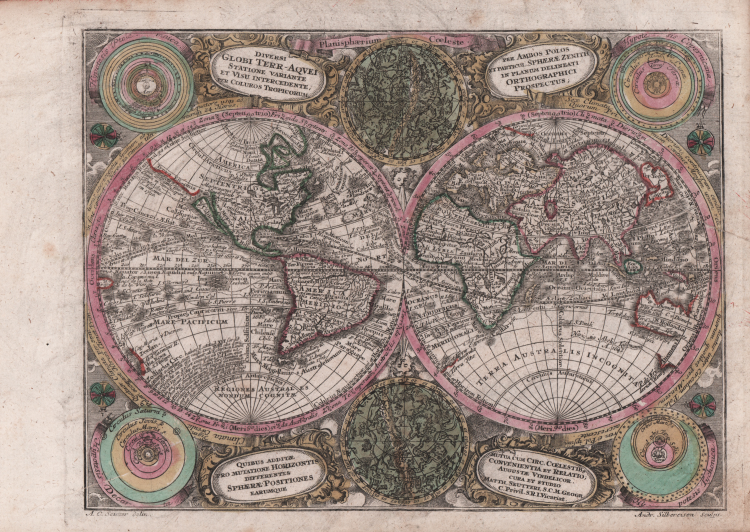



| Reference: | S47445 |
| Author | Matthaus SEUTTER "il vecchio" |
| Year: | 1744 ca. |
| Zone: | The World |
| Printed: | Augsburg |
| Measures: | 270 x 210 mm |


| Reference: | S47445 |
| Author | Matthaus SEUTTER "il vecchio" |
| Year: | 1744 ca. |
| Zone: | The World |
| Printed: | Augsburg |
| Measures: | 270 x 210 mm |
Diversi Globi Terr-Aquei Statione Variante et Visu intercedente, per Coluros Tropicorum, per Ambos Polus et particul. Sphaerae Zenith in planum delineati Orthographici Prospectus.
First state of the small map of the world by Matthesu Seutter, published in the Atlas Minor, Augsburg, circa 1744. The map was later reprinted with the imprint of Tobias Conrad Lotter.
This is the reduced edition after Seutter's larger and beautiful map that is considered one of the most graphic 18th century world maps. California is an Island, Japan is shown in a bizarre shape that incorporates the fictional Terra Yedso. An elongated stretch of land, Terra Esonis extends from Japan to California. The map is filled with detail including the tracks of several explorers. Between the hemispheres are celestial charts of the northern and southern skies, while diagrams of the solar system based on the theories of Ptolemy, Copernicus, Descartes and Tycho Brahe fill the corners. It is set in a richly engraved background of clouds with numerous wind heads and four cartouches. Engraved by Andrea Silbereisen.
Copperplate with original colouring, very good condition.
Matthaus SEUTTER "il vecchio" (1678 - 1757)
|
Matthäus Seutter (1678 - 1757) was one of the most important and prolific German map publishers of the 18th century. Seutter was born the son of a goldsmith but apprenticed as a brewer. Apparently uninspired by the beer business, Seutter abandoned his apprenticeship and moved to Nuremberg where he apprenticed as an engraver under the tutelage of the prominent J. B. Homann. Sometime in the early 1700s Seutter left Homann to return to Augsburg, where he worked for the prominent art publisher jeremiad Wolff (1663 - 1724), for whom he engraved maps and other prints. Sometime around 1717 he established his own independent cartographic publishing firm in Augsburg. Though he struggled in the early years of his independence, Seutter's engraving skill and commitment to diversified map production eventually attracted a substantial following. Most of Seutter's maps are heavily based upon, if not copies of, earlier work done by the Homann and De L'Isle firms. Nonetheless, by 1731/32 Seutter was one of the most prolific publishers of his time and was honored by the German Emperor Karl VI who gave him the title of Imperial Geographer, after which most subsequent maps included the Avec Privilege designation. Seutter continued to publish until his death, at the height of his career, in 1757. Seutter had two engraver sons, Georg Matthäus Seutter (1710 - 173?) and Albrecht Carl Seutter (1722 - 1762). Georg Matthäus quit the business and relocated to Woehrdt in 1729 (and probably died shortly thereafter), leaving the family inheritance to his wastrel brother Albrecht Carl Seutter, who did little to advance the firm until in own death in 1762. Following Albrecht's death, the firm was divided between the established Johann Michael Probst (1727 - 1776) firm and the emerging firm of Tobias Conrad Lotter. Lotter, Matthäus Seutter's son-in-law, was a master engraver and worked tirelessly on behalf of the Suetter firm. It is Lotter, who would eventually become one of the most prominent cartographers of his day, and his descendants, who are generally regarded as the true successors to Matthäus Seutter.
|
Matthaus SEUTTER "il vecchio" (1678 - 1757)
|
Matthäus Seutter (1678 - 1757) was one of the most important and prolific German map publishers of the 18th century. Seutter was born the son of a goldsmith but apprenticed as a brewer. Apparently uninspired by the beer business, Seutter abandoned his apprenticeship and moved to Nuremberg where he apprenticed as an engraver under the tutelage of the prominent J. B. Homann. Sometime in the early 1700s Seutter left Homann to return to Augsburg, where he worked for the prominent art publisher jeremiad Wolff (1663 - 1724), for whom he engraved maps and other prints. Sometime around 1717 he established his own independent cartographic publishing firm in Augsburg. Though he struggled in the early years of his independence, Seutter's engraving skill and commitment to diversified map production eventually attracted a substantial following. Most of Seutter's maps are heavily based upon, if not copies of, earlier work done by the Homann and De L'Isle firms. Nonetheless, by 1731/32 Seutter was one of the most prolific publishers of his time and was honored by the German Emperor Karl VI who gave him the title of Imperial Geographer, after which most subsequent maps included the Avec Privilege designation. Seutter continued to publish until his death, at the height of his career, in 1757. Seutter had two engraver sons, Georg Matthäus Seutter (1710 - 173?) and Albrecht Carl Seutter (1722 - 1762). Georg Matthäus quit the business and relocated to Woehrdt in 1729 (and probably died shortly thereafter), leaving the family inheritance to his wastrel brother Albrecht Carl Seutter, who did little to advance the firm until in own death in 1762. Following Albrecht's death, the firm was divided between the established Johann Michael Probst (1727 - 1776) firm and the emerging firm of Tobias Conrad Lotter. Lotter, Matthäus Seutter's son-in-law, was a master engraver and worked tirelessly on behalf of the Suetter firm. It is Lotter, who would eventually become one of the most prominent cartographers of his day, and his descendants, who are generally regarded as the true successors to Matthäus Seutter.
|